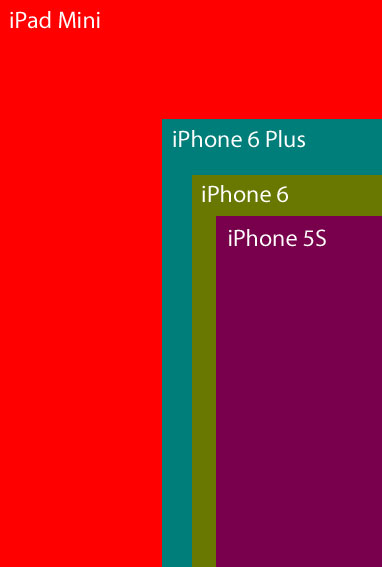Innumeracy is something that I've discussed in the past - both on the podcast and somewhere in the archives (buried so deep even I couldn't find it).
Innumeracy is the title of an excellent book by John Allen Paulos which laments the fact that basic math skills are treated as second class skills. The go-to example: picture the stereotypical PhD student saying the following things:
- "I can't do math well"
- "I can't read well"
Obviously, the second is a bit more absurd... but it is easy to imagine the first one being uttered with nary a hint of irony.
It's not that examples of innumeracy are particularly hard to find - but one example I read recently startled me with it's absolute certainty - so much certainty that it tied the article together and inspired the picture. The offending quote, from the Atlantic: "The new iPhone 6 Plus is nearly as large as an iPad Mini."
What? Is That True?
No - it's nowhere close. But I'll get to that. First, let's back up - what is the complaint?
Roughly, the article links to an excellent article by Turkish Sociologist Zeynep Tufekci on using phones designed for the median buyer's hand size - which happens to be biased towards the larger hands of a man. In her article, she complains about her Google Nexus 4 being too large for her hands and the UI being poorly designed for the hands of a 5'2" woman.
This is where I check my hand size privilege - under the right moisture conditions and with the right ball finish (read: not one of those ridiculous 'outdoor' balls cloaked in rubber), I can palm a regulation size basketball. It makes logical sense that the Nexus 4 might be too large for a shorter woman with a correlated hand size. Here are the stats on the Nexus 4, billed as a 4.7" screen phone:
Height: 5.27 inches
Width: 2.70 inches
Total Surface Area: 14.229 square inches
And the new smaller size iPhone 6, also billed as a 4.7" screen:
Height: 5.44 inches
Width: 2.64 inchesTotal Surface Area: 14.3616 square inches
And now, the iPhone 5s... pre "Bigger than bigger" phones (4 inch screen):
Height: 4.87 inches
Width: 2.31 inchesTotal Surface Area: 11.2497 square inches
Ms. Tufecki wold have a legitimate case against the iPhone 6 - even my 5'8" wife is just about maxed out with the older iPhone. But here's an important thing to realize: the iPhone 6, with the ".7 inch bigger screen" is actually a 27.66% larger phone! Keep this math in mind as we continue.
Back to the iPad Innumeracy
Okay, so the iPhone 6 is slightly larger than the Nexus 4 - and, worse, it grows in height (the limiting dimension) by a bit. Now, let's look on the statistics on this new iPhone 6 Plus, with its 5.5 inch screen:
Height: 6.22 inches
Width: 3.06 inchesTotal Surface Area: 19.0332 square inches
Now we're talking - and it's definitely a good move for Apple to split the line in two with such a large screen size bump. Consider this: the iPhone 6 Plus has a 69.19% larger surface area than the last models of iPhone! Again, importantly: with only a 37.5% increase in 'nominal' screen size.
You can see how this can be confusing when you throw that second dimension into the mix, eh?
Okay, let's now get to the meat of the article... is the iPhone 6 Plus really almost the same size as an iPad Mini with a 7.9 inch screen?
Height: 7.87 inches
Width: 5.3 inchesTotal Surface Area: 41.711 square inches
No, of course not. The iPad Mini is 119.15% larger than the iPhone 6 Plus, and 193.14% larger than the iPhone 6. So, it's more than twice as large as the phone we're supposed to accept is "close in size" . And, if you drop the "Plus" and use the 4.7" model, the width of the iPad is almost the same size as the height of the iPhone!
So, we're to believe that an extra inch and a half of height on the largest model Apple phone, plus a width measurement more than the aforementioned Nexus 4's height is somehow a close comparison to the new 'Phablet' from Apple?
(7. Don't answer that, it's a rhetorical question. Okay, 8.)
Two Dimensions, eh?
Not that industry helps, of course - quick, what's the difference in size between a 42" and an 84" television? (Assuming 16:9 ratios on both - nice try)
Yes, it's a four times larger surface (not two times!) if you grab the 84" screen. Now do this one: 1080p resolution vs. the new 4K resolution (as sold, not as defined - nice try).... how many more pixels will there be?
Four times again, but most people will only guess it because one refers to a vertical resolution: 1920x1080, and the other refers to a horizontal resolution: 3840x2160.
So, where have you seen innumeracy in the wild recently? Any interesting examples? (Did I transpose the dimensions correctly?)

